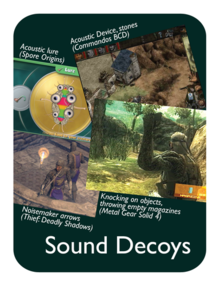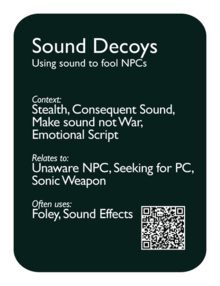Difference between revisions of "Sound Decoys"
ValterAlves (Talk | contribs) m |
ValterAlves (Talk | contribs) m |
||
| Line 16: | Line 16: | ||
| revisions =Introduced in version 1.0. | | revisions =Introduced in version 1.0. | ||
| description = | | description = | ||
| − | |||
A customary component of the gameplay is to deal with enemies along the game space. In some situations it is convenient to divert enemies’ attention and possibly to influence them to change their positions, either to be able to deal with one at time or to avoid confrontation at all. | A customary component of the gameplay is to deal with enemies along the game space. In some situations it is convenient to divert enemies’ attention and possibly to influence them to change their positions, either to be able to deal with one at time or to avoid confrontation at all. | ||
Revision as of 14:30, 18 September 2011

|

| |
| The card's front face | The card's back face |
Synopsis
| Using sound to fool the NPC. |
Relationships
Context:
Stealth ![]() , Consequent Sound
, Consequent Sound ![]() , Make Sound not War
, Make Sound not War ![]() , Emotional Script
, Emotional Script ![]() .
.
Relates to:
Unaware NPC ![]() , Seeking for PC
, Seeking for PC ![]() , Sonic Weapon
, Sonic Weapon ![]() .
.
Often uses:
Foley ![]() , Sound Effects
, Sound Effects ![]() .
.
Description
A customary component of the gameplay is to deal with enemies along the game space. In some situations it is convenient to divert enemies’ attention and possibly to influence them to change their positions, either to be able to deal with one at time or to avoid confrontation at all.
Diverse forms of Sound Decoys can be included in the Gameplay. Sound is particularly suitable for integrating meaningful decoy actions since it allows launching the decoy whilst avoiding visual contact. Spaces with reduced visibility also bring advantages both for the plausibility and of the usefulness of the decoy.
Examples
External Resources
First presentation of pattern Sound Decoys in (Alves & Roque, 2010)





